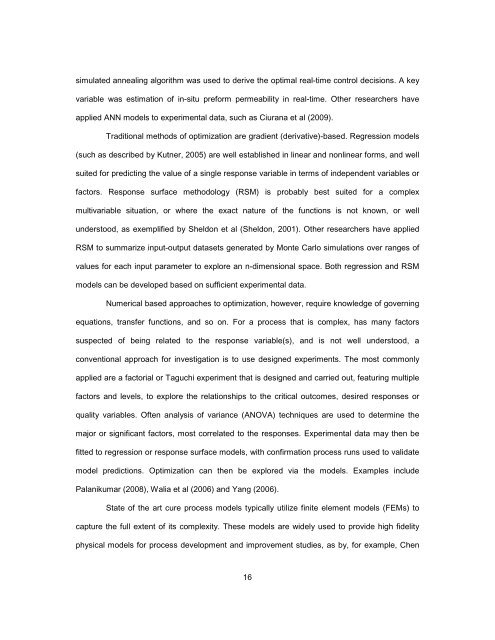TOOLED THICK COMPOSITES by ARVEN H. SAUNDERS III ...
TOOLED THICK COMPOSITES by ARVEN H. SAUNDERS III ...
TOOLED THICK COMPOSITES by ARVEN H. SAUNDERS III ...
Create successful ePaper yourself
Turn your PDF publications into a flip-book with our unique Google optimized e-Paper software.
simulated annealing algorithm was used to derive the optimal real-time control decisions. A key<br />
variable was estimation of in-situ preform permeability in real-time. Other researchers have<br />
applied ANN models to experimental data, such as Ciurana et al (2009).<br />
Traditional methods of optimization are gradient (derivative)-based. Regression models<br />
(such as described <strong>by</strong> Kutner, 2005) are well established in linear and nonlinear forms, and well<br />
suited for predicting the value of a single response variable in terms of independent variables or<br />
factors. Response surface methodology (RSM) is probably best suited for a complex<br />
multivariable situation, or where the exact nature of the functions is not known, or well<br />
understood, as exemplified <strong>by</strong> Sheldon et al (Sheldon, 2001). Other researchers have applied<br />
RSM to summarize input-output datasets generated <strong>by</strong> Monte Carlo simulations over ranges of<br />
values for each input parameter to explore an n-dimensional space. Both regression and RSM<br />
models can be developed based on sufficient experimental data.<br />
Numerical based approaches to optimization, however, require knowledge of governing<br />
equations, transfer functions, and so on. For a process that is complex, has many factors<br />
suspected of being related to the response variable(s), and is not well understood, a<br />
conventional approach for investigation is to use designed experiments. The most commonly<br />
applied are a factorial or Taguchi experiment that is designed and carried out, featuring multiple<br />
factors and levels, to explore the relationships to the critical outcomes, desired responses or<br />
quality variables. Often analysis of variance (ANOVA) techniques are used to determine the<br />
major or significant factors, most correlated to the responses. Experimental data may then be<br />
fitted to regression or response surface models, with confirmation process runs used to validate<br />
model predictions. Optimization can then be explored via the models. Examples include<br />
Palanikumar (2008), Walia et al (2006) and Yang (2006).<br />
State of the art cure process models typically utilize finite element models (FEMs) to<br />
capture the full extent of its complexity. These models are widely used to provide high fidelity<br />
physical models for process development and improvement studies, as <strong>by</strong>, for example, Chen<br />
16
















